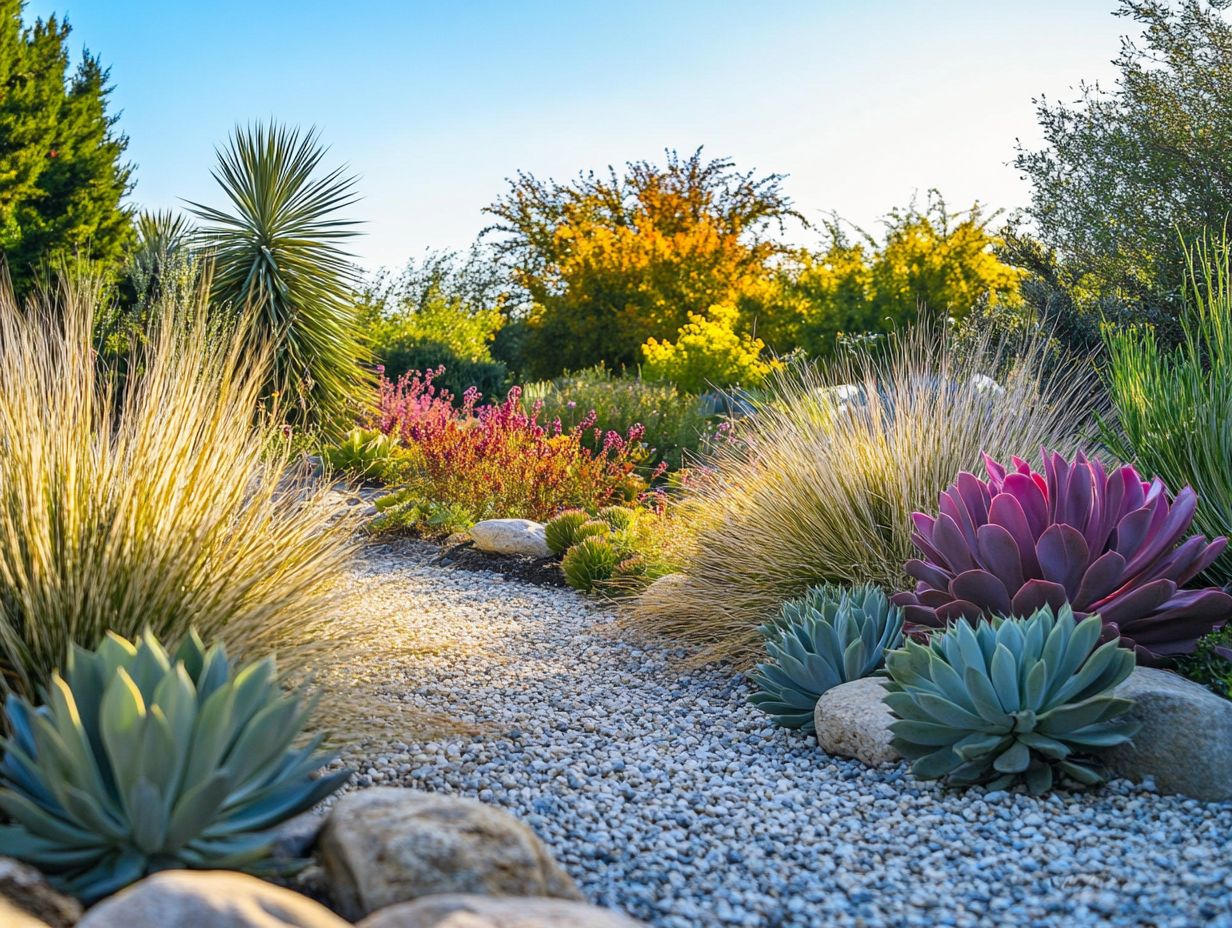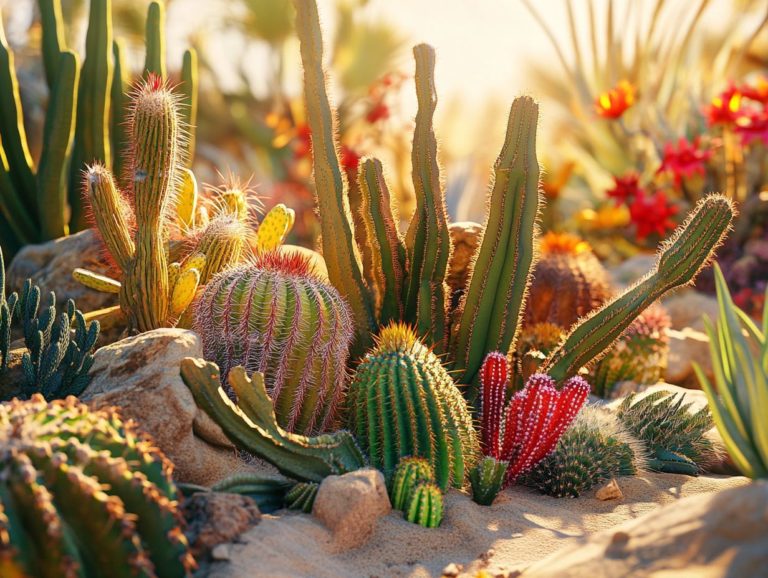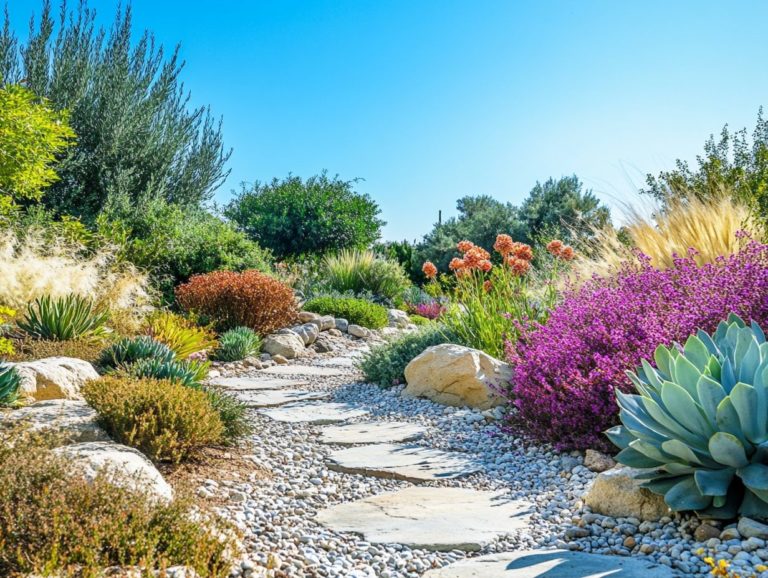Low-Maintenance Drought-Resistant Plants to Consider
Creating a stunning garden can be effortless. Low-maintenance, drought-resistant plants are ideal for drought-tolerant landscaping.
This list presents 15 options, including plants that thrive in tough conditions. They range from colorful succulents to fragrant lavender and ornamental grasses.
Discover why these drought-tolerant plants are game-changers for your garden! Explore what sets these varieties apart, how they can elevate your landscape, and discover tips for seamlessly integrating them into your garden design.
Prepare to effortlessly transform your outdoor space into a vibrant oasis filled with blooming daisy-like flowers!
Contents
Key Takeaways:

- Succulents: Hardy and low-maintenance, drought-tolerant succulents are ideal for dry climates and require little water to thrive.
- Lavender: Not only a beautiful addition to any garden, but also a drought-resistant plant that can withstand hot and dry conditions.
- Coneflower: A hardy and colorful option for low-maintenance gardens, coneflowers are drought-tolerant and attract native pollinators.
1. Succulents
Succulents are truly captivating drought-tolerant plants that thrive in well-draining soil, making them a perfect fit for your waterwise gardening efforts, especially in areas facing climate change and water restrictions.
With their remarkable ability to store water in their robust leaves, succulents not only help you reduce water usage but also infuse vibrant colors and unique textures into your landscape design, attracting pollinators and adding multi-seasonal interest to your garden.
Among the diverse varieties available, Sempervivum, known as hens-and-chicks, presents a stunning rosette shape that flourishes in rocky, poor soil. These hardy beauties prefer full sun and can brave the cold winters, making them ideal for your outdoor displays.
Then there’s Portulaca, or moss rose, which dazzles with its colorful, cup-shaped flowers, perfectly suited for hanging baskets or as ground cover in sandy soils.
Both types require minimal maintenance; a bit of watering during dry spells and the occasional removal of spent blooms will keep them looking vibrant. For those seeking even more options, consider incorporating unique drought-resistant plants for your home. Their resilience and adaptability make them excellent choices for sustainable landscaping that demands very little upkeep.
2. Lavender
Lavender stands as a quintessential drought-tolerant herb, celebrated for its aromatic flowers and remarkable ability to flourish in well-draining soil. This makes it an ideal addition to any drought-resistant garden design, particularly one inspired by the Mediterranean landscape.
Beyond its resilience, lavender contributes significantly to garden biodiversity. By incorporating this stunning plant into your garden beds, you not only attract native pollinators like bees and butterflies but also create a captivating visual contrast when paired with other perennials.
Varieties such as Lavandula angustifolia, known for its compact form and rich color, can elevate a mixed border, introducing layers of texture and interest. These hardy plants require minimal water, which reduces overall maintenance and aligns beautifully with an eco-friendly approach to sustainable gardening.
3. Sage
Sage, the drought-tolerant herb, deserves a place in your garden for its aromatic flowers and remarkable versatility in design. It thrives beautifully in low-water environments, enriching your landscape with its robust foliage.
Among the diverse varieties of sage, Salvia officinalis, known as common sage, stands out not just as a culinary favorite but also as a magnet for bees and butterflies, enhancing the charm of your garden.
Meanwhile, the vibrant purple blooms of Russian sage (Perovskia atriplicifolia) create stunning, colorful drought-resistant borders while providing a fragrant haven for pollinators.
Consider culinary sages, like pineapple sage, which infuse tropical notes into your dishes and pair wonderfully with native wildflowers, presenting a striking visual contrast. These combinations attract beneficial insects and foster a thriving ecosystem, offering sustenance for both people and pollinators alike.
4. Yarrow
Yarrow is a resilient plant that can survive without much water. Its stunning daisy-like flowers make it a fantastic choice for mixed borders and natural erosion control.
The blooms come in sunny yellows, vibrant pinks, soft whites, and deep reds. They attract native pollinators like bees and butterflies.
Yarrow thrives in various soil types, from sandy loams to clay. Even challenging soil conditions won t stop you from enjoying its beauty.
It requires low maintenance, making it ideal for novice and seasoned gardeners. Once established, it needs little care, allowing you to enjoy your landscape effortlessly.
5. Russian Sage
Russian Sage is a breathtaking plant that deserves a spot in your garden. With its striking silvery foliage and tall spikes of purple flowers, it creates a beautiful waterwise border.
This hardy perennial loves full sun and well-drained soil. It flourishes alongside drought-tolerant companions like lavender and yarrow.
Even in winter, the woody stems and muted leaves maintain their shape. This adds visual interest long after other plants have faded.
When paired with ornamental grasses or succulents, Russian Sage transforms your garden into a colorful tapestry. Your outdoor space will remain captivating through multiple seasons.
6. Coneflower
Coneflower, known for its vibrant hues, is a beloved staple in North American gardens. Its long-blooming clusters enhance your space and attract various pollinators.
Echinacea, the most celebrated member of this family, dazzles with striking flower heads. It also offers health benefits like immune support and anti-inflammatory properties.
These resilient plants thrive in full sun and can adapt to less-than-ideal soil conditions. They fit perfectly in different garden settings.
When added to pollinator gardens, coneflowers create a vivid tapestry alongside butterfly bush and black-eyed Susans. Their diverse heights and colors add a dynamic palette to your landscape.
7. Catmint

Catmint is a gem among plants, known for its drought tolerance and vibrant colors. It’s perfect for novice and seasoned gardeners eager to attract pollinators without much fuss.
With species like Nepeta grandiflora and Nepeta racemosa, you can choose from soft blues to vibrant purples. These beauties bloom from late spring to early fall, adding color to your garden.
Adding catmint to your garden elevates its appeal and creates a welcoming space for bees and butterflies. Its fragrant blossoms attract these pollinators beautifully.
Whether in cottage gardens, borders, or as ground cover, catmint provides a stunning backdrop and enhances biodiversity. It’s essential for anyone looking to create a pollinator-friendly landscape.
8. Black-eyed Susan
Black-eyed Susan lights up any garden with its bright blooms. This resilient flower thrives in dry conditions and attracts local pollinators.
Its cheerful yellow petals and dark centers create a striking contrast. This makes it a must-have in any garden focused on beauty.
To thrive, it needs well-drained soil and full sunlight. It can easily be grown from seeds or by dividing existing plants.
Pair them with drought-resistant companions like lavender or ornamental grasses. For inspiration, check out the top 10 drought-resistant plants for landscaping. Together, they create a stunning, low-maintenance garden.
9. Ornamental Grasses
Ornamental grasses can elevate your garden design. They add lush foliage and unique textures while saving water.
Consider Festuca for its gentle blue-green hue, which pairs beautifully with vibrant flowers. Miscanthus and Pennisetum offer graceful movement as they sway in the breeze.
These grasses are easy to care for. They create layered landscapes that add depth and bring your outdoor space to life.
10. Marigolds
Marigolds are vibrant summer flowers that can brighten your garden. These beauties attract helpful insects too!
Available in varieties like African, French, and Signet marigolds, they each bring unique charm. They even help protect vegetables like tomatoes from pests.
Low maintenance and easy to grow, marigolds thrive in full sun. They also enhance biodiversity, supporting a healthier garden.
11. Butterfly Bush
The Butterfly Bush is a stunning addition to any drought-tolerant garden. Its vibrant colors attract butterflies and other pollinators.
With shades from purple to pink and white, these plants bloom in various shapes. Their fast growth fills bare spots quickly.
Cluster them together for eye-catching focal points. They thrive alongside other drought-resistant plants, creating beautiful displays.
These fragrant flowers not only attract butterflies but also look great with other perennials and grasses.
12. Cacti
Cacti are the epitome of drought-tolerant plants that need little water, expertly engineered to thrive in harsh, low-water environments. They are an ideal choice for your Mediterranean region landscapes.
These remarkable plants come in an array of shapes and sizes. From the iconic tall saguaro to the vibrant barrel cactus, each species showcases unique adaptations, such as thickened skins, protective spines, and shallow root systems. These features help them quickly absorb moisture during those rare rains, which are essential for drought-tolerant varieties.
When cultivating cacti especially in areas with extreme temperatures consider factors like soil drainage and light exposure. Different types flourish under varying conditions, so understanding their needs is key for heat-tolerant plants.
Their sculptural forms and striking colors add visual interest to your garden and play a vital role in sustainable landscaping. Cacti also promote biodiversity and reduce water usage, contributing to an eco-friendly environment that you can take pride in while enhancing erosion control.
Key Benefits of Cacti:
- Low-water needs
- Unique shapes and adaptations
- Enhance biodiversity
- Support erosion control
Consider adding cacti to your garden for a stunning, low-maintenance landscape!
13. Rosemary
Don t miss out on rosemary, a beloved drought-tolerant gem that features aromatic flowers and foliage, thriving beautifully in low-water conditions. It s a must-have for any Mediterranean garden.
Beyond its culinary finesse that infuses robust flavor into meats, stews, and even bread, rosemary demonstrates impressive versatility in ornamental landscaping. It is one of the best drought-tolerant herbs.
Varieties like Tuscan Blue and Prostrate each bring their own unique growth habits. These allow you to explore creative arrangements in your garden design. The upright spreading habit types can serve as elegant hedges or striking accent plants, while the trailing forms are perfect for cascading over walls or adorning containers.
This resilient herb prefers well-drained soil and sunny spots, making it an ideal choice for water-efficient gardening. By incorporating rosemary, you enhance both the aesthetics and sustainability of your garden, creating a space that is as beautiful as it is eco-friendly while requiring maintenance-free care.
Key Benefits of Rosemary:
- Low-water needs
- Aromatic and versatile
- Ideal for garden design
- Enhances sustainability
Add rosemary to your collection for a fragrant and useful addition to your garden!
14. Zinnias

Zinnias are the vibrant summer showstoppers you ve been looking for. Not only are they drought-tolerant, but they also attract pollinators, bringing a splash of color to your garden.
With a variety of types from the towering ‘Giant Zinnia’ to the more compact ‘Zahara’ these flowers can easily complement any landscape design. They thrive in well-draining soils and full sun, making them perfect for low-maintenance gardens where you desire hassle-free beauty.
Use them as bold accents in mixed borders or create a riot of color in containers. Zinnias create an eye-catching display. Their resilience means even novice gardeners can achieve stunning results, enhancing the overall palette of your outdoor space while inviting beneficial insects to join the party.
Key Benefits of Zinnias:
- Bright and vibrant colors
- Attract pollinators
- Easy to grow
- Perfect for low-maintenance gardens
Start your zinnia garden today for a colorful, low-maintenance landscape!
15. Aloe Vera
Don’t miss out on Aloe Vera, a fabulous drought-tolerant succulent that will brighten your garden! It is celebrated for its low-water needs and striking foliage. Beyond its visual appeal, it boasts a wealth of medicinal properties and versatility in garden design.
This resilient plant not only enhances the aesthetics of your outdoor spaces but also serves a myriad of health and beauty purposes. Its gel is famous for soothing sunburns, hydrating your skin, and speeding up wound healing. It s an essential component of any natural skincare routine and an important part of an herb garden.
When you grow Aloe Vera indoors, it thrives in well-draining soil and requires minimal sunlight. This makes it perfect for your windowsills or counters.
In outdoor environments, it flourishes in warm climates, adding a vibrant green touch to water-efficient gardening projects. By incorporating Aloe Vera into your landscape design, you support eco-friendly gardening practices while ensuring a sustainable source for natural remedies right at your fingertips.
Key Benefits of Aloe Vera:
- Low-water needs
- Medicinal properties
- Versatile in garden design
- Enhances eco-friendly practices
Consider adding Aloe Vera to your garden for both beauty and natural benefits!
Why Are These Plants Champions of Water Conservation?
Plants that can survive with little water boast fascinating adaptations that empower you to cultivate a thriving garden with minimal water usage. This makes them perfect for sustainable gardening, especially in an era of climate change and tightening water restrictions.
These remarkable species develop deep root systems that reach far beneath the surface, allowing them to access moisture that other plants simply can t. Many also feature specialized water storage capabilities within their leaves or stems, enabling them to retain vital moisture during extended dry spells.
Consider succulents like agave and sedum; they are prime examples of resilience with their plump, fleshy leaves. By adding these drought-tolerant plants to your garden, you save water and create a vibrant ecosystem while boosting biodiversity and reducing the need for man-made substances used to help plants grow. For more information, check out the most resilient drought-resistant plants.
How Can These Plants Benefit a Garden or Landscape?
Incorporating drought-resistant plants for rock gardens into your garden design presents a wealth of advantages. You’ll enjoy reduced water consumption, improved erosion control, and the creation of a pollinator-friendly haven that requires minimal maintenance.
These resilient plants flourish in challenging climates and enhance biodiversity by providing crucial habitats for various species. By choosing native and drought-resistant varieties, you can explore plant companions for drought-tolerant gardens to craft visually stunning landscapes that require little upkeep while dramatically lowering water usage.
This thoughtful approach conserves precious water resources and bolsters local ecosystems, contributing to a healthier environment overall. As more people recognize the aesthetic allure and ecological advantages of these plants, their integration into both public and private spaces becomes increasingly vital for sustainable living.
What Are the Best Growing Conditions for These Plants?
The ideal growing conditions for drought-tolerant plants generally encompass well-draining soil, ample exposure to full sun or partial shade, and a keen understanding of the specific needs of heat-tolerant varieties.
To enhance their vitality and yield, these plants flourish in soil enriched with organic matter, which includes decomposed plants and animals, helping to retain essential moisture during long, dry spells. This is key for drought-tolerant landscaping.
For optimal placement, consider grouping them alongside other water-efficient species to create a beneficial microclimate that promotes better humidity and minimizes evaporation.
Opting for plants native to your region significantly improves their adaptability, as these varieties are often better suited to local weather patterns and soil conditions. Regular mulching also plays a vital role in maintaining soil temperature and moisture levels, ensuring your plants not only survive but thrive.
What Are Some Other Low-Maintenance Plant Options?
In addition to incorporating succulents and drought-tolerant herbs, you’ll find a wealth of low-maintenance plant options, including various ornamental grasses and native plant options for drought-prone regions that thrive in waterwise gardens.
These plants bring texture and vibrant colors to your landscape while requiring minimal watering and care. They re perfect for your busy lifestyle or for those who care deeply about the environment. For instance, ornamental grasses sway gracefully in the breeze, introducing movement and visual interest to your garden.
Meanwhile, flowering perennials can deliver delightful seasonal blooms without demanding much effort. By understanding the specific needs of these plants such as their sunlight exposure and soil conditions you can enhance their resilience and overall appearance, allowing them to flourish while contributing to a sustainable and attractive landscape.
Start your journey towards a sustainable garden today!
How Can You Incorporate These Plants into Your Garden Design?
Incorporating drought-tolerant plants into your garden design is a fun project. Use techniques like waterwise borders and mixed borders to enhance beauty and save water.
Explore exciting plant combinations that blend different textures and colors. For example, pairing lavender’s silvery foliage with the vibrant blooms of desert marigold creates an eye-catching look.
Proper spacing is crucial. Give your plants enough room to grow. This makes them healthier and improves your landscape’s overall appearance.
Integrating native species is beneficial. They require fewer resources and attract local wildlife, creating a thriving environment.
Frequently Asked Questions

What are some low-maintenance drought-resistant plants for my garden?
Great options include lavender, yarrow, sedum, Russian sage, and ornamental grasses.
Do these plants require lots of water?
No, that s the beauty of drought-resistant plants! They thrive in dry conditions and need less water than traditional plants.
Can I still have a colorful garden with these plants?
Absolutely! Many drought-tolerant plants have stunning flowers, such as the purple coneflower and blue fescue grass, making them great choices from the top 10 drought-resistant plants for beginners.
Do these plants attract pests or insects?
No, generally they don’t. Drought-resistant plants have natural defenses against pests, making them a low-maintenance choice.
Will these plants survive in all climates?
It depends on the specific plant and its hardiness zone. Most drought-resistant plants thrive in various climates, but choose ones that suit your region.
How can I keep my drought-resistant plants healthy?
Proper soil preparation and spacing are key. Water regularly during the first year, and they will need less attention afterward.
Start designing your garden today with these amazing drought-resistant plants!






